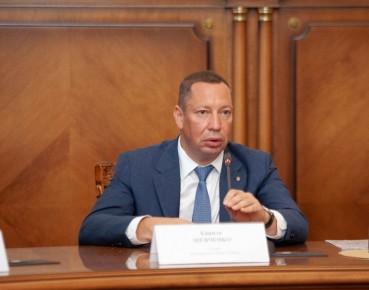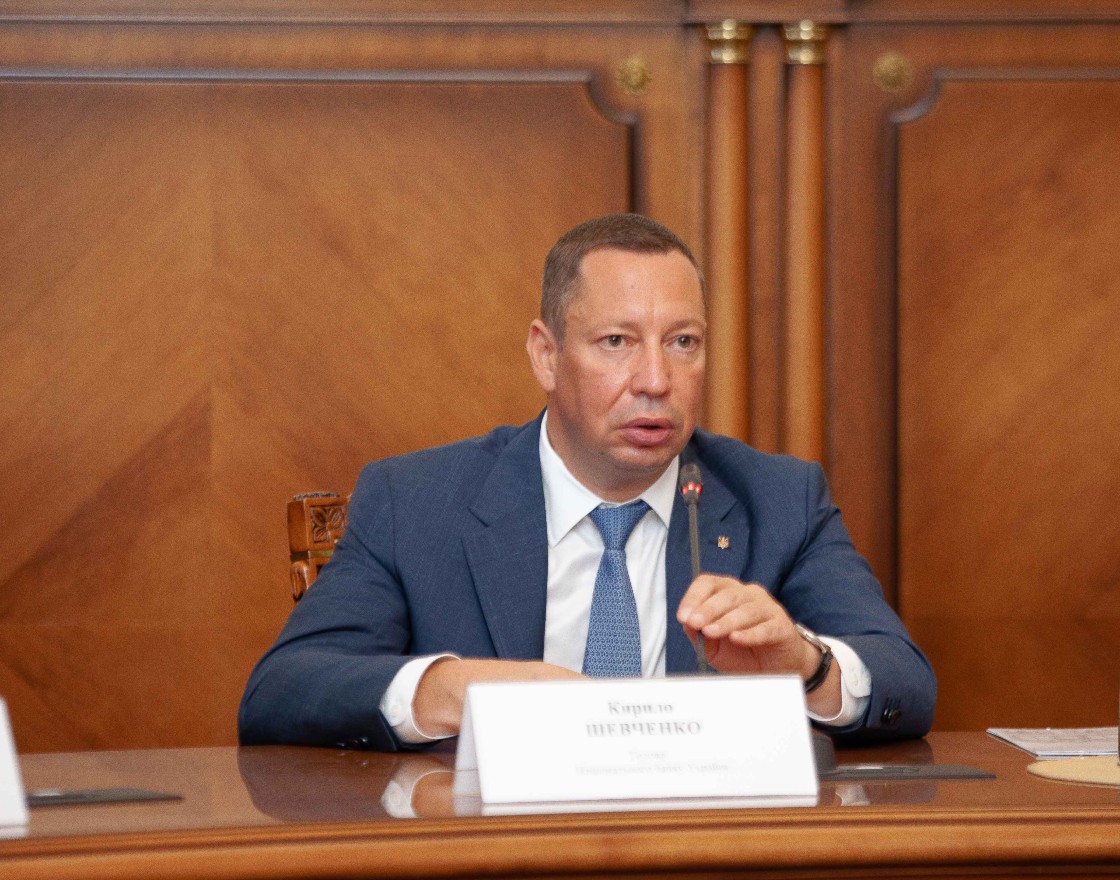
Kyrylo Shevchenko, Governor of the NBU (Yelyzaveta Serhiienko/NBU, CC BY-NC-ND 2.0)
“I have decided to step down because of the political pressure that has been exerted on the central bank for a long time. There is pressure to make decisions not justified economically, but focused on short-term victories and this may be potentially costly to Ukrainians and the Ukrainian economy in the long term,” said Mr. Smoliy.
After three weeks of vacancy, the Ukrainian parliament appointed the new governor of the NBU. This post was assumed by Kyrylo Shevchenko, a banker with 25 years of experience in the field. Mr. Shevchenko worked in the Aval Bank and at the Finance and Credit Bank. In the years 2006-2009, he was a CEO of the State Mortgage Institution, which sought to stimulate mortgage lending in Ukraine. In 2009, Mr. Shevchenko worked for several months as an adviser to the then-Prime Minister Yulia Tymoshenko, and then he served as vice-president of the state-owned Ukrgasbank until April 2010. In the years 2012-2014, he was an adviser at the largest Ukrainian state-owned bank Oschadbank (the State Savings Bank of Ukraine). In 2014, Mr. Shevchenko was once again hired by Ukrgasbank, and starting from 2015 he served as its CEO.
Continuation and changes
“The NBU will remain an independent institution. The decisions will still be made in a professional and economically justified manner. I promise that we will remain technocrats,” stated Mr. Shevchenko after being appointed as the new governor of the NBU.
Mr. Shevchenko announced that the NBU would continue its policy of economic cooperation with international financial institutions and foreign investors. In his opinion, it is entirely realistic that within five years Ukraine could become a regional financial hub that will attract investors from all over the world.
Meanwhile, the NBU will continue to support the implementation of the basic policy directions set out in the “Strategy of development of state-owned banks.” Mr. Shevchenko argues that the changes introduced in the corporate governance of state-owned banks have been one of the success-stories of Ukraine’s reforms thus far.
Thanks to these changes the state-owned banks have become the most effective institutions of the financial sector. The continued implementation of the strategy will be conducive to the strengthening of competition, which — in combination with the monetary policy of the NBU — will result in lower costs of credit for businesses and individual customers.
According to Mr. Shevchenko, during the coronavirus pandemic the Ukrainian banking system has confirmed its resilience in the face of crises, and this was to a large extent thanks to the policy pursued by the central bank. However, the risks associated with COVID-19 haven’t passed yet.
The new governor of the NBU believes that the main priority in the central bank’s activities is to support the economy. In his opinion, the central bank should create the necessary conditions for the expansion of lending activity. At present, one of the main directions of growth of the banks’ loan portfolio are consumer loans, which are a relatively easy instrument, but do not generate positive outcomes for the economy as a whole and for the Ukrainian people.
In order to change this, the NBU is supposed to assist in rebalancing the banks’ portfolios. On the one hand, it wants to strengthen activities aimed at reducing the share of non-performing loans in the banking system and improving the quality of the banks’ loan portfolios. On the other hand, it wants to limit the use of long-term securities, which the banks are purchasing using their spare resources, instead of allocating them on loans to enterprises. At the same time, the NBU should continue the policy of reducing the base rate, which will make loans less expensive.
According to Mr. Shevchenko, there is still much to be done in order to “reduce the pressure on the banks” in light of the COVID-19 pandemic. Among the tasks for the near future, the new head of the NBU also mentioned the need to “review the effectiveness of loan payment holidays”, that is, the deferment of loan repayments because as a result of this policy the banks have fewer available resources, and without them they are not able to increase their lending activity. The package of measures concerning the banking sector is supposed to enable the resumption of lending to companies in the real sector of the economy.
A strong or weak UAH?
“The central bank is supposed to be the foundation of macroeconomic stability, and its monetary policy is supposed to help maintain it. As an independent regulatory body, the NBU is supposed to promote long-term economic growth in the conditions of a stable national currency,” said the Ukrainian President Volodymyr Zelensky during the presentation of the new governor. Mr. Zelensky’s statement at a meeting with Ukrainian entrepreneurs, which was held in early July, provided a better picture of how this could look in practice.
“Many companies have suffered because of the low exchange rate of the hryvnia, which has persisted in Ukraine in recent years,” said Mr. Zelensky shortly after the parliament dismissed the previous head of the NBU. “Everyone told us that we had an independent central bank. Yes, we will maintain the independence of the National Bank of Ukraine. But we have to ask how we are supposed to get by if even the state budget is calculated according to the exchange rate of UAH 30 per US dollar, and you all see what it really is,” said the Ukrainian president. A correction of the exchange rate of Ukraine’s national currency is one of the first expectations associated with the appointment of the new head of the NBU.
The recent artificial strengthening of the UAH is not only the result of activities of the central bank, but primarily those of the Ministry of Finance, which has been flooding the market with USD on the occasion of subsequent issues of UAH-denominated government bonds with very high interest rates. As it turned out recently, these bonds were also purchased by the Ukrainian president, who invested UAH5m (USD 178.037), without disclosing this information in his financial statement.
Mr. Zelensky’s expectations concerning the hryvnia have sparked a lively debate. According to Ihor Petrashko, the Minister of Economic Development, Trade and Agriculture, the UAH exchange rate was used for manipulations that negatively affected the condition of the Ukrainian economy, while the management of the central bank was passive and did not intervene to stop these negative processes.
“The strengthening of the exchange rate to UAH23.5 per USD1 in the last year resulted in the collapse of our industry and GDP. When the exchange rate drops from UAH28.5 to UAH23 per USD1, we know the devastating consequences this has for our export-oriented economy. Let’s look at Poland, the other EU member states. These are big economies, but even these countries are competing with each other through their exchange rates,” assessed Mr. Petrashko.
In his view, the central bank should cut the interest rates, while the inflation rate, for which it is responsible, is currently too low in relation to the real condition of the economy.
For Ukraine, the normal inflation is 8-9 per cent, while the NBU inflation target is 5-6 per cent. Ukraine needs a stable exchange rate. The exchange rate of UAH23.5 per USD1 has hurt, among others, agriculture. The companies from that sector had to pay for the imports of fertilizers, pesticides, and fuel at the exchange rate of UAH28/USD1, while the profits from the exports of their products were converted at the rate of UAH23/USD1.
As a result of the exchange rate fluctuations, the profit margins shifted out of the production sector and into the non-production sector. At a time when Ukrainian producers were incurring losses, the yield on hryvnia-denominated bonds issued and guaranteed by the government reached 30 per cent in the absence of any risk to the buyers.
According to Mr. Petrashko, the NBU should be buying out the foreign currency entering the market in order to prevent the appreciation of the UAH. “We would then have greater reserves and an exchange rate of UAH27 per USD1. There would be no decline in GDP. The decline in GDP is not the fault of the government but of the NBU, with its incomprehensible exchange rate policy that pushed money from the real sector to the unproductive sectors in the fourth quarter of last year,” commented the Minister of the Economy in an interview with the agency RBK.
Meanwhile, the Ukrainian Prime Minister, Denys Shmyhal assured that the government did not make any demands towards the NBU with regard to the exchange rate. “No one is discussing such matters with the central bank. The central bank conducts an independent monetary policy. In accordance with the Constitution and the law, its basic objectives include maintaining the stability of the domestic currency, the stability of the financial system, and price stability in the country. This is not a subject for discussion about additional or specific issues, this is not a matter of artificially inflating or lowering the exchange rate. In our country the exchange rate is regulated by the market,” argued Mr. Shmyhal. The PM stated that the government did not intend to stimulate economic development through the devaluation of the hryvnia, and that instead it was focusing on increasing the level of investment in Ukrainian companies.

